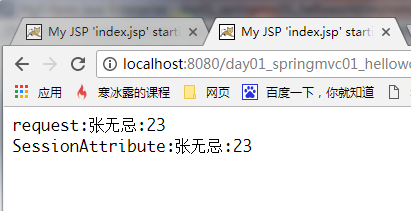SpringMVC之數據存儲
阿新 • • 發佈:2017-10-02
alt string servle nat 參數 urn row lan map類型
1、使用request域對象存儲數據:將請求中的參數存儲在request中,使用setAttribute()方法可以在jsp頁面訪問該屬性。
@RequestMapping("/test17")
public String test17(HttpServletRequest request String name) throws IOException {
request.setAttribute("name", name);
return SUCCESS;
}
2、使用session域對象存儲數據:
// 存儲數據:session
@RequestMapping("/test18")
public String test18(HttpSession session, String name) throws IOException {
session.setAttribute("name", name);
return SUCCESS;
}
3、使用ModelAndView存儲數據:new ModelAndView(SUCCESS);中的SUCCESS是設置執行完該函數後將要跳轉的頁面。ModelAndView既可以存儲八大基本類型的數據,也可以存儲List、Set、Map類型的集合。
// 存儲數據:ModelAndView
@RequestMapping("/test19")
public ModelAndView test19(String name) throws IOException {
ModelAndView mav = new ModelAndView(SUCCESS);
ArrayList<String> list = new ArrayList<String>();
list.add("Anna");
list.add("Jay");
list.add("Joe");
list.add("John");
mav.addObject("list", list);
HashMap<String, Integer> map = new HashMap<String, Integer>();
map.put("a", 12);
map.put("b", 23);
map.put("c", 34);
mav.addObject("map", map);
mav.addObject("name", name);
return mav;
}
4、使用Model對象存儲數據
// 存儲數據:Model
@RequestMapping("/test20")
public String test20(Model model) {
model.addAttribute("name", "任我行");
ArrayList<String> list = new ArrayList<String>();
list.add("Anna");
list.add("Jay");
list.add("Joe");
list.add("John");
model.addAttribute("list", list);
HashMap<String, Integer> map = new HashMap<String, Integer>();
map.put("a", 12);
map.put("b", 23);
map.put("c", 34);
model.addAttribute("map", map);
return SUCCESS;
}
5、使用Map存儲數據
// 存儲數據:Map
@RequestMapping("/test21")
public String test21(Map<String, Object> map) {
map.put("name", "任我行");
ArrayList<String> list = new ArrayList<String>();
list.add("Anna");
list.add("Jay");
list.add("Joe");
list.add("John");
map.put("list", list);
return SUCCESS;
}
6、將請求參數保存一份到session當中
在類上加上註解:@SessionAttributes
@SessionAttributes(names={"name", "age"}, types={String.class, Integer.class})
方法代碼:
// 存儲數據:將請求參數保存一份到session當中
@RequestMapping("/test22")
public String test22(String name, Integer age, ModelMap model) {
return SUCCESS;
}
結果:

SpringMVC之數據存儲
